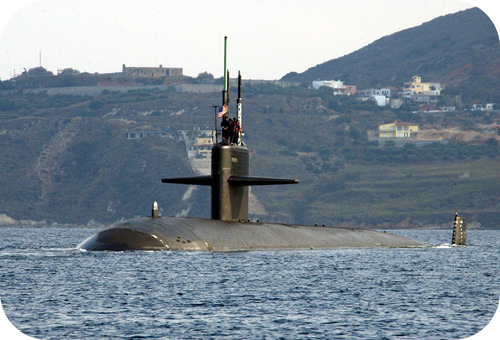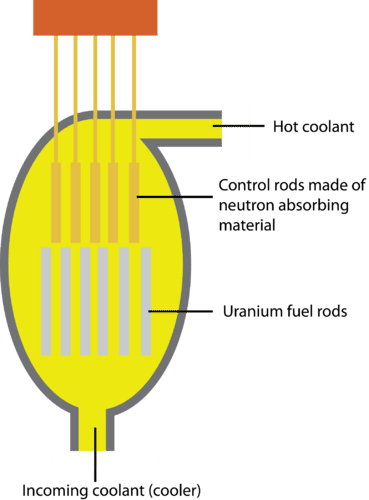核反应堆
章节大纲
-
There are many applications of . The applications range from scientific research in physics , medicine, and agriculture to industrial measuring, nuclear weapons, and electricity generation. The particular application shown in the photo is the USS Newport News nuclear-powered attack submarine. In terms of nuclear fuel supply, the USS Newport News leaves port with sufficient fuel to remain underwater for 20 years. In nuclear naval vessels, the nuclear reaction produces steam and the steam then runs the ship.
::应用范围从物理学、医学和农业的科学研究到工业测量、核武器和发电等。照片中显示的具体应用是美国航天局新港新闻核动力攻击潜艇。 在核燃料供应方面,美国航天局新港新闻(USS Newport Newport New New New New New New New New New New New New New New New New New New New New New New) 的燃料足以让港口在水下维持20年。 在核舰艇中,核反应产生蒸汽,而蒸汽则运行该船。Fission Reactors
::裂变反应堆A nuclear reactor is a device in which a nuclear chain reaction is carried out at a controlled rate. When the controlled chain reaction is a fission reaction, the reactor is called a fission reactor. Fission reactors are used primarily for the production of electricity, although there are a few fission reactors used for military purposes and for research. The great majority of electrical generating systems all follow a reasonably simple design. The nuclear reaction boils water into steam, the steam is used to spin a turbine, and the turbine turns an electrical . After the water is turned into steam, the sequence in a fossil fuel generating plant and a nuclear generating plant are approximately the same. Of course, with the nuclear plant, the reaction chamber must be inside a containment building.
::核反应堆是一种以控制速度进行核链反应的装置。当受控链反应是裂变反应时,该反应堆被称为裂变反应堆。裂变反应堆主要用于发电,尽管有几个裂变反应堆用于军事目的和研究目的。绝大多数发电系统都遵循合理的简单设计。核反应将水煮成蒸汽,蒸汽用于涡轮机,涡轮机将电转换为电。水变成蒸汽后,化石燃料发电厂和核电厂的顺序大致相同。当然,与核电厂一样,反应室必须位于封闭建筑内。Fissionable Fuel
::易裂变燃料Naturally occurring uranium is composed almost entirely of two isotopes, uranium-238 (99%) and uranium-235 (1%). It is the uranium-235 that is fissionable (will undergo fission) and therefore, this is the uranium isotope than can be used for fuel in a nuclear reactor. For uranium to be used as fuel, the percent of uranium-235 must be increased to at least 3%. Uranium in which the U-235 content is more than 1% is called enriched uranium. Somehow, the two isotopes must be separated so that enriched uranium is available for use as fuel. Separating the isotope by chemical means (chemical reactions) is not successful because the isotopes have exactly the same chemistry. The only essential difference between U-238 and U-235 is their atomic masses; as a result, the two isotopes are separated by a physical means that takes advantage of the difference in mass.
::天然产生的铀几乎全部由两种同位素组成,即铀238(99%)和铀235(1%),铀235是可裂变的(将裂变的),因此,这是核反应堆中可用于燃料的铀同位素,因此,这是铀同位素,不能用作核反应堆中的燃料;要将铀235用作燃料,其百分比必须提高到至少3%。铀-235含量超过1%的铀铀称为浓缩铀。尽管如此,两种同位素必须分离,以便浓缩铀可以用作燃料。通过化学手段(化学反应)分离同位素并不成功,因为同位素具有完全相同的化学成分。铀-238和铀-235之间的唯一基本区别是它们的原子质量;因此,这两种同位素通过利用质量差异的物理手段分离出来。Once the supply of U-235 is acquired, it is placed in a series of long cylindrical tubes called fuel rods. These fuel cylinders are bundled together with control rods (see diagram below) made of neutron-absorbing material. The amount of generated by the chain reaction is controlled by the rate at which the nuclear reaction occurs. The rate of the nuclear reaction is dependent on how many neutrons are emitted by one U-235 nuclear disintegration and how many strike a new U-235 nucleus to cause another disintegration. The purpose of the control rods is to absorb some of the neutrons and thus stop them from causing further disintegrations. The control rods can be raised or lowered into the fuel rod bundle. When the control rods are lowered all the way into the fuel rod bundle, they absorb so many neutrons that the chain reaction essentially stops. When more heat is desired, the control rods are raised so that the chain reaction speeds up and more heat is generated. The control rods are operated in a fail-safe system so that power is necessary to hold them up. During a power failure, gravity will pull the control rods down to shut off the system.
::铀-235的供应一旦获得,它就被放置在一系列称为燃料棒的长圆柱管中。这些燃料瓶与由中子吸收材料制成的控制棒(见下文图)一起捆绑在一起。链反应产生的量由核反应发生的速度控制。核反应的速度取决于铀-235核分解释放多少中子,以及有多少个新的铀-235核核核核分解再造成另一分解。控制棒的目的是吸收一些中子,从而阻止它们进一步解体。控制棒可以提升或降低到燃料棒捆中。当控制棒全部降低到燃料棒捆中时,它们吸收了如此多的中子,以至于链反应基本停止。当需要更多热时,控制棒会升高,以便链反应速度加快,产生更多的热。控制棒是在一个不起作用的系统中操作,因此需要电源来支撑这些中子的分解。当控制棒被拉低时,控制棒将拉紧。U-235 nuclei can capture neutrons and disintegrate more efficiently if the neutrons are moving slower than the at which they are released. Fission reactors use a moderator surrounding the fuel rods to slow down the neutrons. Water is not only a good coolant but also a good moderator, so a common type of fission reactor has the fuel core submerged in a huge pool of water. This type of reactor is called a light water reactor or LWR. All public electricity generating fission reactors in the United States are LWRs.
::U-235核可以捕捉中子,如果中子的移动速度慢于释放速度,则更高效地分解中子。Fision反应堆使用燃料棒周围的调节器来减慢中子。水不仅是一个好的冷却器,也是一个好的调节器,因此常见的裂变反应堆将燃料芯淹没在巨大的水池中。这种反应堆被称为轻水反应堆或液态水反应堆。在美国,所有公共发电的裂变反应堆都是液态水反应堆。You can follow the operation of an electricity-generating fission reactor in the image above. The reactor core is submerged in a pool of water. The heat from the fission reaction heats the water, which is pumped into a heat exchange container. There the heated water boils the water in the heat exchanger. The produced steam is forced through a turbine that spins a generator and produces electricity. After the water passes through the turbine, it is condensed back to liquid water and pumped back to the heat exchanger.
::您可以在以上图像中跟踪发电裂变反应堆的运行情况。 反应堆核心被淹没在水池中。 裂变反应产生的热能使被抽入热交换容器的水加热。 热水将热交换器中的水煮开。 产生的蒸汽通过一个涡轮机,该涡轮机旋转发电机并发电。 水经过涡轮机后,水被凝结为液态水,抽回热交换器。Breeder Reactors
::育种反应堆U-235 is the only naturally occurring fissile isotope, and it constitutes less than 1% of naturally occurring uranium. A fissile substance is a substance capable of sustaining a chain reaction of . It has been projected that the world's supply of U-235 will be exhausted in less than 200 years. It is possible, however, to convert U-238 to a fissionable isotope that will function as a fuel for nuclear reactors. The fissionable isotope is plutonium-239 and is produced by the following series of reactions:
::铀-235是唯一天然生成的裂变同位素,占天然生成铀的不到1%。裂变材料是一种能够维持连锁反应的物质。据预测,全世界铀-235的供应将在不到200年的时间内耗尽。然而,有可能将铀-238转化为可裂变同位素,作为核反应堆的燃料。可裂变同位素为钚-239,由以下一系列反应产生:
::092238U+01n092239U1-0e+093239Np1-0e+094239PuThe final product from this series of reactions is plutonium-239, which has a of 24,000 years and is another nuclear reactor fuel. This series of reactions can be made to occur inside an operating nuclear reactor by replacing some of the control rods with rods of U-238. As the nuclear decay process proceeds inside the reactor, it produces more fuel than it uses. It would take about 20 such breeder reactors to produce enough fuel to operate one additional reactor. The use of breeder reactors would extend the fuel supply a hundred fold. The problem with breeder reactors, however, is that plutonium is an extremely deadly poison. Furthermore, unlike ordinary fission reactors, it is possible for out-of-control breeder reactors to explode. None of the civilian nuclear power plants in the U.S. are breeder reactors.
::这一系列反应的最终产物是钚239, 钚239有24 000年的历史,是另一种核反应堆燃料。这一系列反应可以在运行中的核反应堆内发生,用U-238杆取代一些控制杆。此外,随着核衰变过程在反应堆内发展,它产生的燃料比它使用的要多。需要大约20个这样的核子反应堆来生产足够的燃料来运行一个额外的反应堆。使用核子反应堆可以将燃料供应扩大100倍。但是,核子反应堆的问题是钚是一种极其致命的毒药。此外,与普通的裂变反应堆不同,失控的核子反应堆有可能爆炸。美国民用核电厂没有一个是繁殖反应堆。Launch the PLIX Interactive below to start a chain reaction by causing a neutron to collide with a uranium atom:
::启动下面的PLIX互动, 引发连锁反应, 导致中子与铀原子相撞 :Summary
::摘要-
A nuclear reactor is a device in which a nuclear chain reaction is carried out at a controlled rate.
::核反应堆是一种装置,其核链反应以受控速进行。 -
The nuclear reaction boils water into steam, the steam is used to spin a turbine, and the turbine turns an electrical generator.
::核反应把水煮成蒸汽,蒸汽用来旋转涡轮机,涡轮发电。 -
It is the uranium-235 that is fissionable (will undergo fission) and therefore, this is the uranium isotope than can be used for fuel in a nuclear reactor.
::铀-235是可裂变的(将裂变),因此,这是铀同位素,不能用于核反应堆的燃料。 -
Uranium in which the U-235 content is more than 1% is called enriched uranium and can be used as fuel in a fission reactor.
::铀-235含量超过1%的铀称为浓缩铀,可用作裂变反应堆的燃料。 -
Once the supply of U-235 is acquired, it is placed in a series of long cylindrical tubes called fuel rods.
::铀-235的供应一旦获得,即放置在一系列称为燃料棒的长圆柱管中。 -
These fuel cylinders are bundled together with control rods made of neutron-absorbing material.
::这些燃料气瓶与用中子吸收材料制成的控制棒捆绑在一起。 -
The purpose of the control rods is to absorb some of the neutrons and thus stop them from causing further disintegrations.
::控制棒的目的是吸收一些中子,从而阻止它们造成进一步解体。 -
The control rods can be raised or lowered into the fuel rod bundle. When the control rods are lowered all the way into the fuel rod bundle, they absorb so many neutrons that the chain reaction essentially stops.
::控制棒可以提升或降低到燃料棒捆绑中,当控制棒一路降低到燃料棒捆绑中,它们吸收了如此多的中子,链状反应基本上停止。 -
When more heat is desired, the control rods are raised so that the chain reaction speeds up and more heat is generated.
::当需要加热时,控制杆就会升高,以便链式反应速度加快,产生更多的热。 -
The control rods are operated in a fail-safe system so that power is necessary to hold them up. During a power failure, gravity will pull the control rods down to shut off the system.
::控制杆在故障安全系统中操作,因此需要动力来支撑它们。 在电力故障时,重力会拉下控制杆关闭系统。 -
It is possible, however, to convert U-238 to a fissionable isotope that will function as a fuel for nuclear reactors. This process is carried out in reactors called breeder reactors.
::但是,有可能将U-238转换为可裂变同位素,作为核反应堆的燃料,这一过程在称为育种反应堆的反应堆中进行。 -
None of the civilian nuclear power plants in the U.S. are breeder reactors.
::美国民用核电厂没有一个是繁殖反应堆。
Review
::回顾-
Nuclear power plants produce electricity through
-
induced fission
::诱导裂变 -
induced fusion
::诱发聚变 -
beta decay
::β衰变
::核电厂通过诱发裂变诱发聚变贝贝衰变生产电力 -
induced fission
-
U-235 nuclei split when struck by
-
a proton
::一个质子 -
a neutron
::a 中子 -
an electron
::电子
::U-235 核核在被质子撞击时分裂 中子 电子 -
a proton
-
The most important difference between a nuclear power plant and a fossil fuel plant is
-
the size of the generator.
::发电机大小。 -
the shape of the generator.
::发电机的形状。 -
the fuel.
::燃料。
::核电厂和矿物燃料厂之间最重要的区别是发电机的大小、发电机的形状、燃料。 -
the size of the generator.
-
Which of the following will function as fuel in a fission reactor?
-
hydrogen
::氢氢 -
coal
::煤炭 -
all isotopes of uranium
::铀的所有同位素 -
only U-235
::只有铀-235
::氢煤,所有铀同位素,只有铀-235 -
hydrogen
Explore More
::探索更多Use this resource to answer the questions that follow.
::使用此资源回答下面的问题 。-
What does PWR stand for?
::PWR代表什么? -
What do the control rods do?
::控制杆是做什么的? -
Once the steam is generated, what is it used for?
::蒸汽一旦产生,用于什么用途?
-
A nuclear reactor is a device in which a nuclear chain reaction is carried out at a controlled rate.


